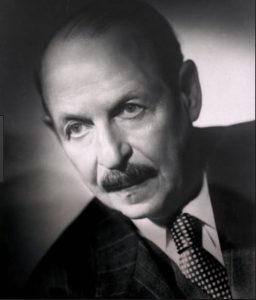Emmerich Kálmán was born on 24 October 1882 in the Hungarian town of Siofok. His father was a well-to-do businessman but was reduced to bankruptcy during Kálmán’s childhood, an experience which left a lasting mark on young Kálmán’s imagination. The family moved to Budapest, then one of the twin capitals of the Austro-Hungarian Empire, and despite his

Emmerich Kálmán
father’s determination that Kálmán should make a career in law it soon became evident that the call of music was too strong to be ignored. Originally Kálmán’s ambition was to be a concert pianist, but this was thwarted by an affliction to his arm-muscles. In Kálmán’s own words “I was as one who had fallen from the clouds, a very serious and very sad young man”. Indeed, according to that great historian of Viennese operetta, Bernard Grun, Kálmán remained that way inclined all his life. “Even at times of his greatest triumphs”, wrote Grun, “the stocky man with the friendly blue eyes generally looked very serious and very sad. Rapture and high spirits were as foreign to his nature as bad manners and uncouthness. The Csardas-cavalier was a sober and careful citizen who did his work, kept his finances in order and quietly went on his way.”
But to return to Kálmán’s youth. He studied composition in Budapest with Professor Koessler, who also taught Bartók and Kodály. In 1907 his serious compositions won him the prestigious Franz-Joseph Prize of the City of Budapest, but within a year he had registered his first outstanding success as an operetta composer. This was Herbstmanöver (Autumn Manoeuvres), which not only brought him to the attention of the operetta moguls in Vienna but even reached the stages of London and New York. Within a couple of years, Kálmán had moved to Vienna, a city which, since the rebirth of operetta with Lehár’s irresistible Merry Widow in 1905, had been gripped by a positive epidemic of operetta fever. With Der Zigeunerprimás (1912) Kálmán achieved what he himself always regarded as his finest score, and it moved the authoritative critic Richard

Yvonne Kálmán
Specht to write: “If, after the experiences of the past season, I were to choose one of the operetta-maestri as the man for whose talents I had the highest hopes, that man would be Kálmán.” Specht’s hopes were not betrayed when, in 1915, Kálmán produced what was to remain his greatest popular success, Die Csárdásfürstin (The Gypsy Princess). Outstanding among his later works were the enchanting Gräfin Maritza (Countess Maritza) (1924) and Die Zirkusprinzessin (The Circus Princess) (1926), and at least four of his other operettas were a great deal more than merely passing successes. In 1938 Kálmán sought refuge from the Nazis in the United States. After the war, he returned to Europe and died in Paris on 30 October 1953.
–Naxos: History of Emmerich Kálmán

